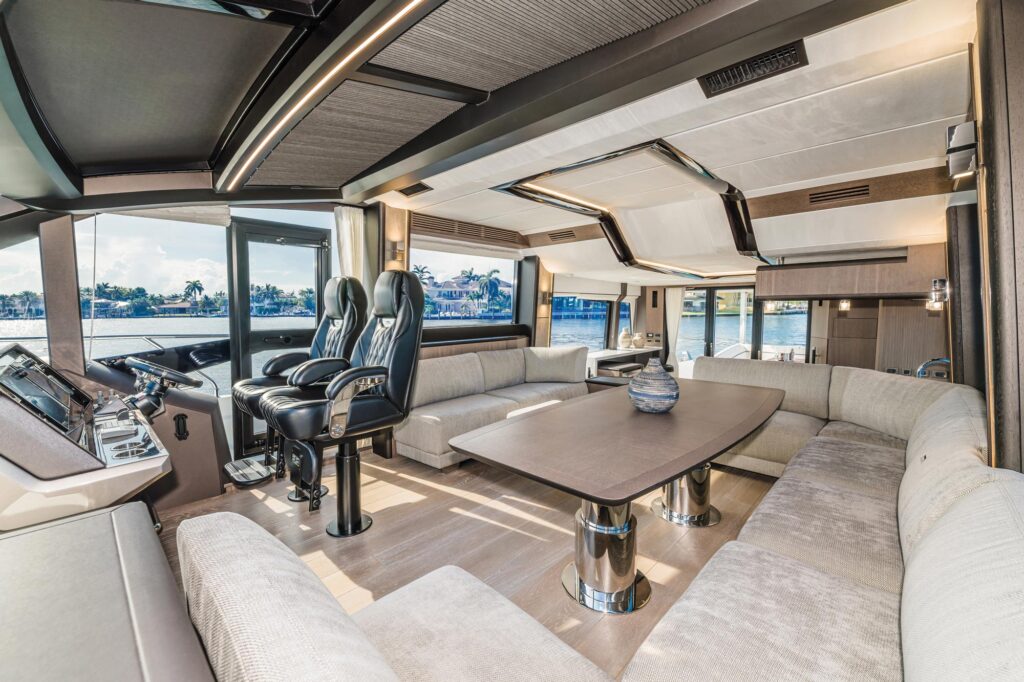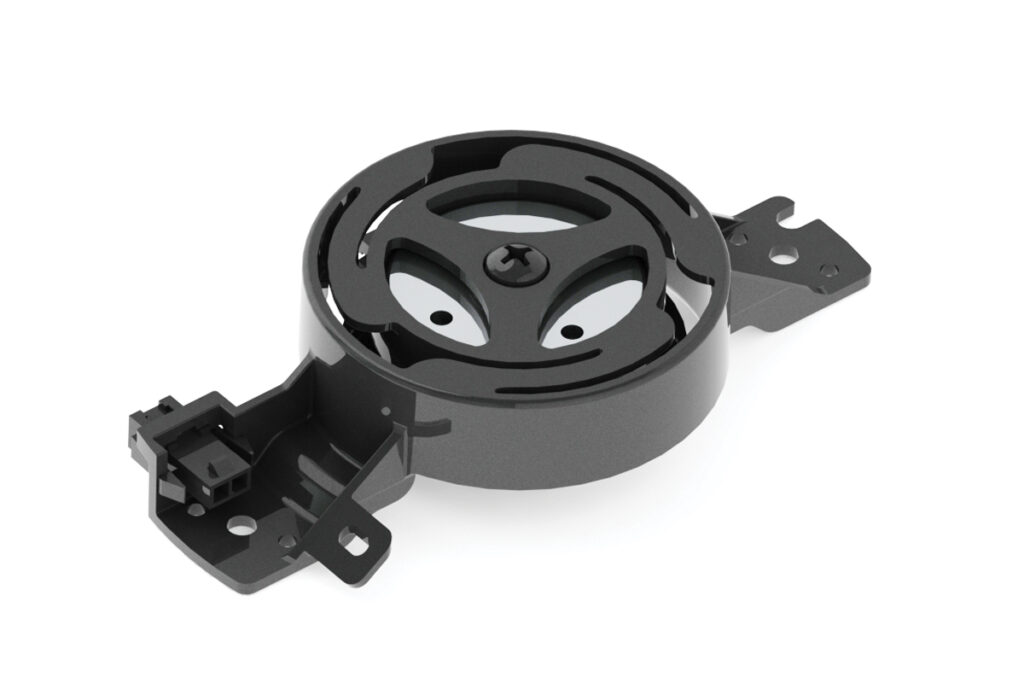SB Television
G3 Acoustics Brings Immersive Audio Onboard
 If you love great-sounding music but don’t like bulky-looking speakers, G3 Acoustics is worth a listen.
Courtesy Galeon Yachts
If you love great-sounding music but don’t like bulky-looking speakers, G3 Acoustics is worth a listen.
Courtesy Galeon Yachts
It was absolutely incredible,” says Patrick Sciacca, Yachting’s editor-in-chief and a former professional musician, about his first time experiencing G3 Acoustics’ immersive audio system. Sciacca had just stepped aboard a Galeon 680 Fly in Miami, and a blues tune was playing. But instead of spotting telltale speaker grilles, Sciacca saw a clean-looking salon and heard consistent sound. It didn’t fluctuate in volume or levels. “Anybody who has a set of ears and listens to music could appreciate the level of awesome that the system provided,” he says. “No matter where you sat in the boat, the sound was equally good.”
Sciacca assumed the speakers were hidden, but he soon learned that G3 Acoustics had transformed the ceiling panels themselves into speakers. The setup was fundamentally different from traditional speakers, which can sound great but sometimes result in inconsistent volume and levels throughout a yacht. And, of course, their grilles can disrupt belowdecks aesthetics.
G3 Acoustics instead worked with high-power, low-distortion transducers that turn interior headliner panels into planar radiating speakers that please ears without distracting eyes.
Traditional speakers typically rely on magnets and voice coils to drive sound-producing speaker cones. The speakers are often relatively heavy and require installation space to accommodate their grille-enclosed speaker cones. Also, because speaker cones project sound in specific directions, they sometimes produce sweet-spot areas that sound great, while other areas are less acoustically impressive.
Rob Hamelink and Brian Servis each spent many years in the automotive sector, where they innovated the idea of removing speakers from car doors and turning headliners into planar radiating speakers. The automotive industry didn’t adopt their idea, so they formed G3 Acoustics in 2013 and developed their technology for the aviation sector with their partner, Bongiovi Acoustic Labs (founded by Tony Bongiovi, the legendary music engineer, studio designer and producer). Today, 450-plus private jets use G3’s systems, and the company’s marine division established in 2023 has turned its attention to production yachts.
If you’ve played an acoustic guitar, you have a basic appreciation for how planar radiating speakers work. In layman’s terms, a player strikes a string, causing it to vibrate. These vibrations resonate the guitar’s acoustically tuned top (or soundboard) and are transmitted to its back and sides, which resonate through the air inside the guitar’s sound chamber. The resulting sound emanates from the guitar’s sound hole.
 To tune each new yacht model and create the correct DSP, G3 Acoustics’ engineers play master reference songs they know. Two examples include Michael Jackson’s “Thriller” and “Beat It.” “We’re just listening for certain subtleties,” Hamelink says.
Courtesy G3 Acoustics
To tune each new yacht model and create the correct DSP, G3 Acoustics’ engineers play master reference songs they know. Two examples include Michael Jackson’s “Thriller” and “Beat It.” “We’re just listening for certain subtleties,” Hamelink says.
Courtesy G3 Acoustics
Instead of strings, G3 Acoustics uses a series of small, lightweight transducers bonded to the backsides of headliner panels. These low-profile transducers each weigh about 3.2 ounces and include neodymium magnets that vibrate when they receive signals from the stereo.
“Transducers transfer one form of energy to another, in this case electrical energy into vibrations,” Hamelink says. “We’re vibrating those headliner panels, sending a bending wave into them.”
The result, he says, is that the entire panel becomes a speaker: “We put transducers on all of the panels that we have access to, and it creates a very immersive, uniform audio experience.”
While a traditional stereo system might place eight speakers inside a larger yacht, G3 Acoustics might use 40 transducers. “No matter where you are in the boat,” Hamelink says, “you’re kind of in the speaker.”
But unlike a high-quality acoustic guitar, whose tonewood top was selected for its acoustic properties and then mechanically tuned to produce great sound, headliner panels are typically made from run-of-the-mill plywood. To create great sound out of acoustically dull materials, G3 Acoustics uses digital signal processing (DSP), which resides on the system’s amplifier. Bongiovi Acoustic Labs created the digital-processing algorithms.
“That’s really kind of the secret sauce,” Hamelink says. “We’re remastering the music in real time with our custom amplifier, with his algorithm, to make panels sound like high-end speakers.”
While Hamelink says that lighter, stiffer headliner materials make for more efficient planar radiating speakers, G3 Acoustics’ transducers and DSP work with most materials.
“When we’re done with the installation, our audio engineer comes in and tunes the boat like he’s mixing a record in a studio,” Hamelink says. “With that digital processing, we can compensate for the material behavior to get the output we want.”
Stereo installers who are fitting traditional speakers often attempt to optimize sound in certain areas (say, in front of a TV), but the G3 Acoustics process is far more immersive. “We’re not setting a microphone in the middle of the room running a sweep and saying, ‘This is what sounds perfect,’ because music is emotional. It’s a sense,” Hamelink says. “And who better than a trained audio engineer [who] mixes records to come into that environment and try to mix a record like he was in the studio?”
Given the amount of time it takes to tune a boat and create a bespoke DSP, G3 Acoustics’ business model focuses on working with production builders rather than one-off builds or aftermarket conversions. G3 Acoustics has done some aftermarket conversions on production builds, though; the idea is that the audio engineer can create a DSP profile for each yacht in a line.
This profile is then flashed onto the system’s custom amplifier—which means yacht owners can use any stereo they like. “We just want the original signal,” Hamelink says.
G3 Acoustics currently only builds equipment for interior spaces. If you’re interested in creating an onboard sound experience unlike anything else afloat, this could be the ticket. After all, if the system impresses Yachting’s editor-in-chief—a guy with sharp ears who once earned his livelihood using his Fender Stratocaster—odds are excellent that it will blow your mind.
Take the next step: g3acoustics.com
The post G3 Acoustics Brings Immersive Audio Onboard appeared first on Yachting.
- Home
- About Us
- Write For Us / Submit Content
- Advertising And Affiliates
- Feeds And Syndication
- Contact Us
- Login
- Privacy
All Rights Reserved. Copyright , Central Coast Communications, Inc.